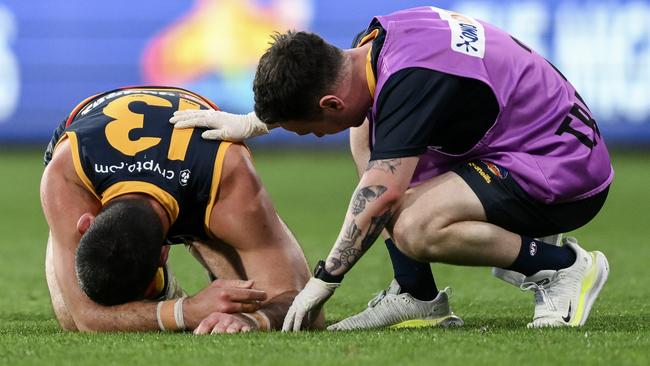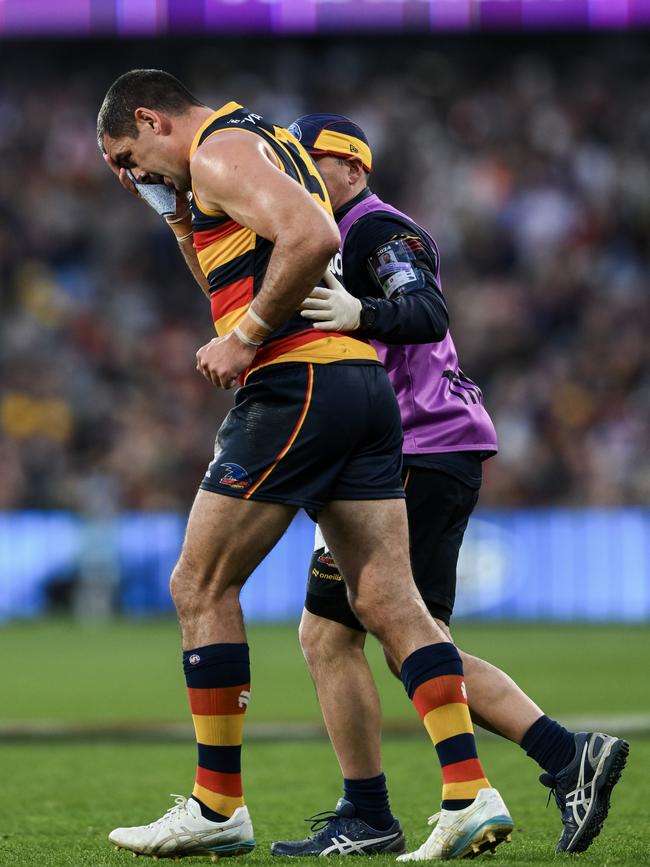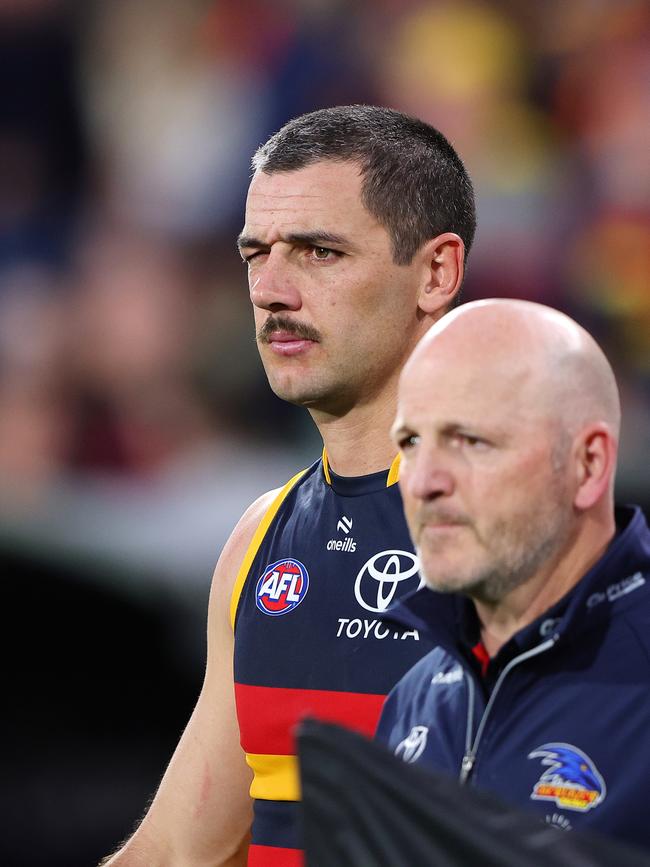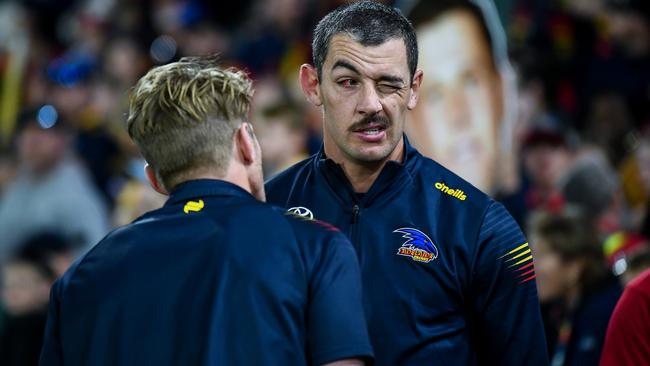Taylor Walker’s eye injury scared Crows’ followers, however, there is a bigger issue to play out | Graham Cornes
Taylor Walker’s eye injury sent a scare through the ranks of Crows’ followers, however, there is a much bigger issue yet to play out writes Graham Cornes.
Opinion
Don't miss out on the headlines from Opinion. Followed categories will be added to My News.
Taylor Walker’s eye injury sent a scare through the ranks of Crows’ followers, and indeed through the broader football community.
But apparently he will miss only the one game – at this stage. However, there is a much bigger issue yet to play out.
The most ominous spectre looming over football at the moment is the long-term effect of concussion.
Legions of lawyers are girding up to attack the AFL on behalf of ex-footballers claiming the debilitating effects of too many head knocks. More about that later.
Walker’s incident seemed so innocuous.
A late, half-hearted attempt to spoil by Western Bulldogs ruckman Tim English last Sunday caught him in the eye.
There seemed nothing to it but he went down and didn’t get up. In obvious pain, he writhed around like an Australian Olympic breakdancer. So it was serious.

Of all the football injuries, an eye injury is the most frustrating.
The danger of losing sight is real but that’s not the frustrating part.
Everything else works fine. You can still run, you can still jump, you can still communicate. But you can’t see out of the injured eye and your vision, at best, is blurred.
With a bit of luck, it will clear up after a couple of hours when the game is over, but at least you can be ready for the next week. In more serious cases, surgery is required.
Walker’s was serious and needed surgical intervention. There was damage to his pupil and a small tear to his retina.
As an aside, one wonders at the skill of an eye surgeon who can repair such a delicate organ. By all accounts, the operation was successful and Walker could be available for Adelaide’s last game of the season.
But why risk it?
Why go to Sydney for a game that means nothing more than inflated bragging rights for the Crows’ disappointing season? No, rest and make sure the eye is right.
Walker doesn’t need to prove anything and he should by now be assured of a contract for next season.
He’s still important to that forward line. Any delay can only be about terms and conditions – and salary!
Obviously, he is not going to command the same salary as when he was in his prime, but he deserves to be rewarded for so many years of service.
He has led the team through the darkest, most difficult times. As much as the club has been good to him, it owes him.
I’ve written before in this column about Rory Sloane’s career-ending eye injury and the memories it brought back. Russell Ebert lying in a hospital bed in Perth after receiving a knock in the eye in as SA v WA state match at Subiaco Oval was asobering sight. Ebert was indestructible on the footy field, but his powers were reduced to those of a mere mortal by a simple poke in the eye.


It resulted in a hyphema – bleeding behind the eye.
Confined to a hospital bed, Ebert was still defiant and optimistic. He threw me the dark glasses he had been given to wear. “Here, you can have them,” he said.
I don’t know why I took them, but I did. Teammate Max James lightened the mood by writing obscenities on the eye patch that he had to wear for several days. He couldn’t see them, but the hospital staff could. The surgeon was not amused. Ebert was in hospital in Perth for a week before he could come home.
Greg Edwards, the first Central District player to kick 100 goals, was instantly blinded in his left eye when a violent collision tore away the optic nerve from the back of his eyeball.
He is blind forever in that eye and his league career was effectively over from that moment – another footballer who has a permanent disability resulting from his playing days.
There are so many.
Very few footballers escape without permanent effect.
The AFL is now beset by mounting litigation from players claiming that it has been negligent in protecting them against concussion.
The class action is mounting and ex-players are queuing to join.
Complicating the issue is that many of them played in the old VFL days.
If they have a case, why wouldn’t those who played in the WAFL or the SANFL have similar rights? And what about minor, suburban and country leagues?
If this case is to succeed, why wouldn’t a player severely injured in a country association be similarly be able to sue that league?
The big difference is the AFL is seen as the corporate monster with plenty of money.
The smaller leagues would have no chance of settling any judgment for compensation.
This is especially so now that Zurich, a major global insurance company, has refused to provide cover for head/concussion injuries.
At the risk of alienating old friends, the rate at which so many ex-players are joining the action must pose the question: are these genuine claims or is it seen as an opportunity for a quick, convenient money-grab?
Particularly when head injuries are so hard to prove.
Secondly, why shouldn’t the permanent debilitating effects of other injuries be treated with the same concern and access to compensation?
For instance, most footballers end up later in life with chronic pain and restrictions from injuries sustained in their playing days. We all suffer from old injuries to our joints, namely knees, ankles, hips and back.
Anything to do with the head is seen as catastrophic, but a back injury can be much more restrictive, not to mention painful. We laugh off old injuries, groaning every time we stand up, climb stairs or worse, descend them.
“It was worth it,” we say. Who would change it?
We all took head knocks. I doubt there is a player who played at the senior level who wasn’t stunned or rendered unconscious at some stage. It might even be worse in country and suburban leagues.

If you could, you got up and soldiered on. At worst, you rested for a couple of days and fronted up again the following week. I don’t see too many old teammates or opponents claiming compensation from the SANFL or the AFL.
In the 1980s, there emerged, mainly in Australia, a phenomenon called RSI, which is an acronym for repetitive strain injury. RSI, chronic pain in the wrist and arms, affected mainly keyboard operators in the Commonwealth public service. By 1985, it had reached epidemic proportions, with compensatory claims escalating dramatically as the media highlighted the issue.
But by the end of that decade, the “epidemic” had miraculously disappeared. Today, with keyboard use more prevalent, very few people suffer from RSI. One can’t help but wonder how many of these claims were for genuine or imagined symptoms.
So it is with football. If these claims for concussion are genuine and if the AFL should be culpable, why then would Sloane’s and Walker’s eye injuries, the back injury of that old broken-down legend from Flinders Park or thousands of other SANFL players’ chronic knee injuries also not be eligible for compensation?
The AFL will defend the claims. It will be a very interesting outcome.






